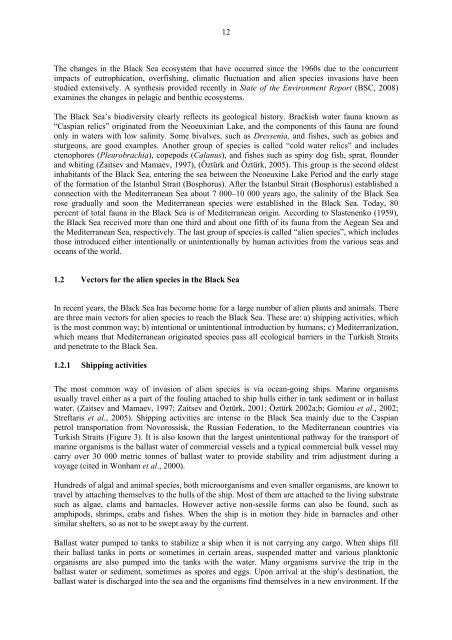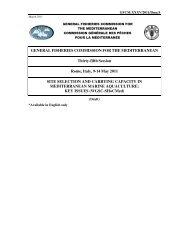Status of alien species in the Mediterranean and Black Sea
Status of alien species in the Mediterranean and Black Sea
Status of alien species in the Mediterranean and Black Sea
You also want an ePaper? Increase the reach of your titles
YUMPU automatically turns print PDFs into web optimized ePapers that Google loves.
12<br />
The changes <strong>in</strong> <strong>the</strong> <strong>Black</strong> <strong>Sea</strong> ecosystem that have occurred s<strong>in</strong>ce <strong>the</strong> 1960s due to <strong>the</strong> concurrent<br />
impacts <strong>of</strong> eutrophication, overfish<strong>in</strong>g, climatic fluctuation <strong>and</strong> <strong>alien</strong> <strong>species</strong> <strong>in</strong>vasions have been<br />
studied extensively. A syn<strong>the</strong>sis provided recently <strong>in</strong> State <strong>of</strong> <strong>the</strong> Environment Report (BSC, 2008)<br />
exam<strong>in</strong>es <strong>the</strong> changes <strong>in</strong> pelagic <strong>and</strong> benthic ecosystems.<br />
The <strong>Black</strong> <strong>Sea</strong>’s biodiversity clearly reflects its geological history. Brackish water fauna known as<br />
“Caspian relics” orig<strong>in</strong>ated from <strong>the</strong> Neoeux<strong>in</strong>ian Lake, <strong>and</strong> <strong>the</strong> components <strong>of</strong> this fauna are found<br />
only <strong>in</strong> waters with low sal<strong>in</strong>ity. Some bivalves, such as Dressenia, <strong>and</strong> fishes, such as gobies <strong>and</strong><br />
sturgeons, are good examples. Ano<strong>the</strong>r group <strong>of</strong> <strong>species</strong> is called “cold water relics” <strong>and</strong> <strong>in</strong>cludes<br />
ctenophores (Pleurobrachia), copepods (Calanus), <strong>and</strong> fishes such as sp<strong>in</strong>y dog fish, sprat, flounder<br />
<strong>and</strong> whit<strong>in</strong>g (Zaitsev <strong>and</strong> Mamaev, 1997), (Öztürk <strong>and</strong> Öztürk, 2005). This group is <strong>the</strong> second oldest<br />
<strong>in</strong>habitants <strong>of</strong> <strong>the</strong> <strong>Black</strong> <strong>Sea</strong>, enter<strong>in</strong>g <strong>the</strong> sea between <strong>the</strong> Neoeux<strong>in</strong>e Lake Period <strong>and</strong> <strong>the</strong> early stage<br />
<strong>of</strong> <strong>the</strong> formation <strong>of</strong> <strong>the</strong> Istanbul Strait (Bosphorus). After <strong>the</strong> Istanbul Strait (Bosphorus) established a<br />
connection with <strong>the</strong> <strong>Mediterranean</strong> <strong>Sea</strong> about 7 000–10 000 years ago, <strong>the</strong> sal<strong>in</strong>ity <strong>of</strong> <strong>the</strong> <strong>Black</strong> <strong>Sea</strong><br />
rose gradually <strong>and</strong> soon <strong>the</strong> <strong>Mediterranean</strong> <strong>species</strong> were established <strong>in</strong> <strong>the</strong> <strong>Black</strong> <strong>Sea</strong>. Today, 80<br />
percent <strong>of</strong> total fauna <strong>in</strong> <strong>the</strong> <strong>Black</strong> <strong>Sea</strong> is <strong>of</strong> <strong>Mediterranean</strong> orig<strong>in</strong>. Accord<strong>in</strong>g to Slastenenko (1959),<br />
<strong>the</strong> <strong>Black</strong> <strong>Sea</strong> received more than one third <strong>and</strong> about one fifth <strong>of</strong> its fauna from <strong>the</strong> Aegean <strong>Sea</strong> <strong>and</strong><br />
<strong>the</strong> <strong>Mediterranean</strong> <strong>Sea</strong>, respectively. The last group <strong>of</strong> <strong>species</strong> is called “<strong>alien</strong> <strong>species</strong>”, which <strong>in</strong>cludes<br />
those <strong>in</strong>troduced ei<strong>the</strong>r <strong>in</strong>tentionally or un<strong>in</strong>tentionally by human activities from <strong>the</strong> various seas <strong>and</strong><br />
oceans <strong>of</strong> <strong>the</strong> world.<br />
1.2 Vectors for <strong>the</strong> <strong>alien</strong> <strong>species</strong> <strong>in</strong> <strong>the</strong> <strong>Black</strong> <strong>Sea</strong><br />
In recent years, <strong>the</strong> <strong>Black</strong> <strong>Sea</strong> has become home for a large number <strong>of</strong> <strong>alien</strong> plants <strong>and</strong> animals. There<br />
are three ma<strong>in</strong> vectors for <strong>alien</strong> <strong>species</strong> to reach <strong>the</strong> <strong>Black</strong> <strong>Sea</strong>. These are: a) shipp<strong>in</strong>g activities, which<br />
is <strong>the</strong> most common way; b) <strong>in</strong>tentional or un<strong>in</strong>tentional <strong>in</strong>troduction by humans; c) Mediterranization,<br />
which means that <strong>Mediterranean</strong> orig<strong>in</strong>ated <strong>species</strong> pass all ecological barriers <strong>in</strong> <strong>the</strong> Turkish Straits<br />
<strong>and</strong> penetrate to <strong>the</strong> <strong>Black</strong> <strong>Sea</strong>.<br />
1.2.1 Shipp<strong>in</strong>g activities<br />
The most common way <strong>of</strong> <strong>in</strong>vasion <strong>of</strong> <strong>alien</strong> <strong>species</strong> is via ocean-go<strong>in</strong>g ships. Mar<strong>in</strong>e organisms<br />
usually travel ei<strong>the</strong>r as a part <strong>of</strong> <strong>the</strong> foul<strong>in</strong>g attached to ship hulls ei<strong>the</strong>r <strong>in</strong> tank sediment or <strong>in</strong> ballast<br />
water. (Zaitsev <strong>and</strong> Mamaev, 1997; Zaitsev <strong>and</strong> Öztürk, 2001; Öztürk 2002a;b; Gomiou et al., 2002;<br />
Streftaris et al., 2005). Shipp<strong>in</strong>g activities are <strong>in</strong>tense <strong>in</strong> <strong>the</strong> <strong>Black</strong> <strong>Sea</strong> ma<strong>in</strong>ly due to <strong>the</strong> Caspian<br />
petrol transportation from Novorossisk, <strong>the</strong> Russian Federation, to <strong>the</strong> <strong>Mediterranean</strong> countries via<br />
Turkish Straits (Figure 3). It is also known that <strong>the</strong> largest un<strong>in</strong>tentional pathway for <strong>the</strong> transport <strong>of</strong><br />
mar<strong>in</strong>e organisms is <strong>the</strong> ballast water <strong>of</strong> commercial vessels <strong>and</strong> a typical commercial bulk vessel may<br />
carry over 30 000 metric tonnes <strong>of</strong> ballast water to provide stability <strong>and</strong> trim adjustment dur<strong>in</strong>g a<br />
voyage (cited <strong>in</strong> Wonham et al., 2000).<br />
Hundreds <strong>of</strong> algal <strong>and</strong> animal <strong>species</strong>, both microorganisms <strong>and</strong> even smaller organisms, are known to<br />
travel by attach<strong>in</strong>g <strong>the</strong>mselves to <strong>the</strong> hulls <strong>of</strong> <strong>the</strong> ship. Most <strong>of</strong> <strong>the</strong>m are attached to <strong>the</strong> liv<strong>in</strong>g substrate<br />
such as algae, clams <strong>and</strong> barnacles. However active non-sessile forms can also be found, such as<br />
amphipods, shrimps, crabs <strong>and</strong> fishes. When <strong>the</strong> ship is <strong>in</strong> motion <strong>the</strong>y hide <strong>in</strong> barnacles <strong>and</strong> o<strong>the</strong>r<br />
similar shelters, so as not to be swept away by <strong>the</strong> current.<br />
Ballast water pumped to tanks to stabilize a ship when it is not carry<strong>in</strong>g any cargo. When ships fill<br />
<strong>the</strong>ir ballast tanks <strong>in</strong> ports or sometimes <strong>in</strong> certa<strong>in</strong> areas, suspended matter <strong>and</strong> various planktonic<br />
organisms are also pumped <strong>in</strong>to <strong>the</strong> tanks with <strong>the</strong> water. Many organisms survive <strong>the</strong> trip <strong>in</strong> <strong>the</strong><br />
ballast water or sediment, sometimes as spores <strong>and</strong> eggs. Upon arrival at <strong>the</strong> ship’s dest<strong>in</strong>ation, <strong>the</strong><br />
ballast water is discharged <strong>in</strong>to <strong>the</strong> sea <strong>and</strong> <strong>the</strong> organisms f<strong>in</strong>d <strong>the</strong>mselves <strong>in</strong> a new environment. If <strong>the</strong>
















